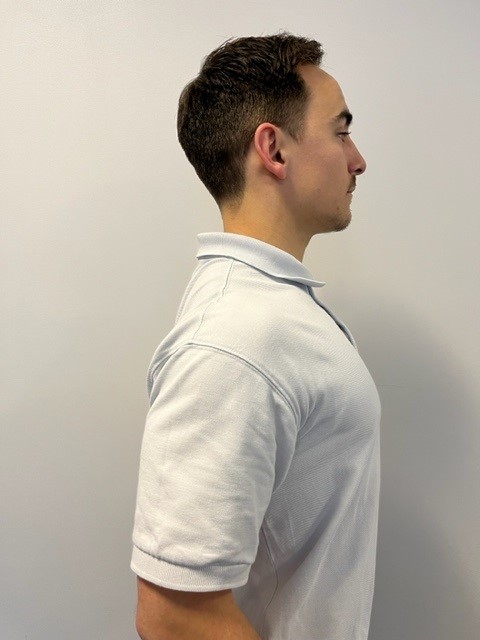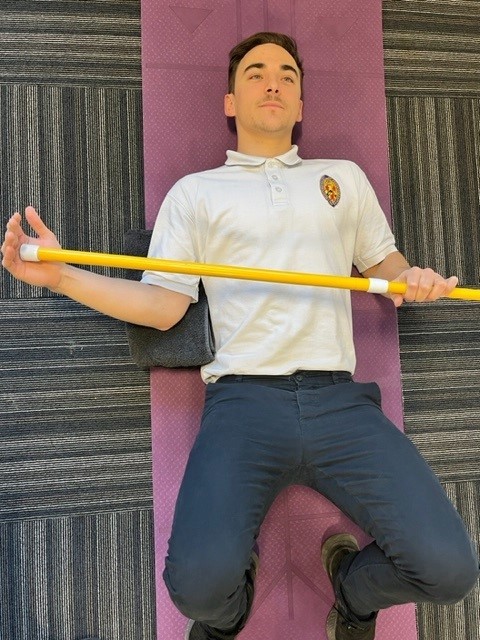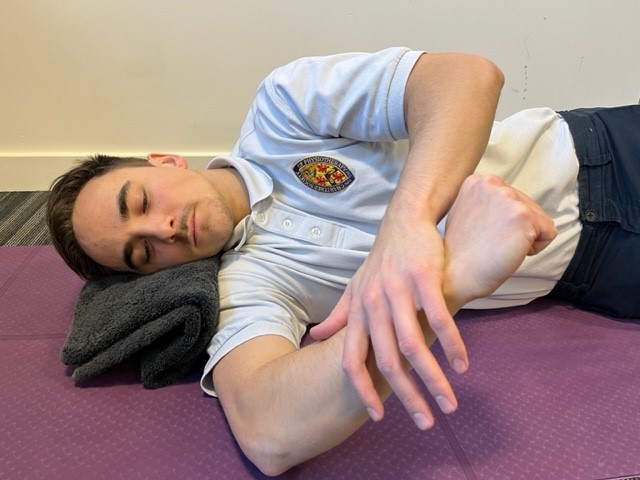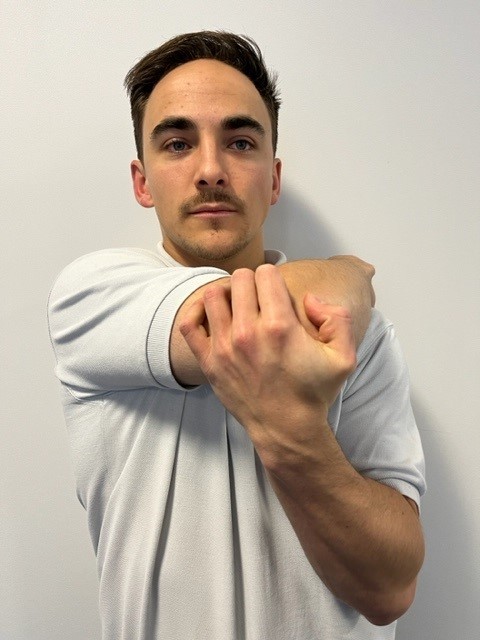On this page
The shoulder is a ball and socket joint (glenohumeral joint). It is designed to allow a large amount of movement. Your arm (humerus) fits into the shallow socket (glenoid) which is part of the shoulder blade (scapula). There is a loose bag or ‘capsule’ which surrounds the joint.
What is a stiff shoulder?
A stiff shoulder (sometimes referred to as frozen shoulder or adhesive capsulitis) is a condition where the shoulder becomes painful and restricted, particularly in rotation and when lifting the arm out to the side. It is thought that the stiffness and pain could be caused by muscle guarding and tightening of the structures in and around the shoulder.
It often occurs in people aged between 40 and 65 years of age and is more common in women. It is more common in those who have diabetes and some other conditions, including overactive thyroid disease. It can also develop after shoulder injury.
Note: Frozen shoulder is not a form of arthritis and other joints are not affected.
Causes
The exact cause of a stiff shoulder is not known. Sometimes it can develop without any identifiable reason. In approximately 15% of cases, individuals have previous shoulder injuries.
Symptoms
The most common symptom is restricted movement. You may notice difficulty putting your hand behind your head or raising your arm out to the side. There is often pain associated with these movements and certain positions; you may also notice pain at night.
What can I do to help my symptoms?
In most people a stiff shoulder will eventually get better on its own. The timescale for full recovery can range from a few months up to 5 years.
Pain relief
Simple analgesia such as Paracetamol and an anti-inflammatory such as Ibuprofen can be very effective for the management of stiff shoulders. You can obtain advice regarding medication from your local pharmacist or GP but remember to read the packet; and do not take over the recommended dosage.
Steroid infection
A steroid injection may be helpful in the initial painful stage to provide short term pain relief if pain medication doesn’t control your pain. You can discuss access to a steroid injection with your GP or local Musculoskeletal service.
Cold or hot packs
Some people find applying a warm or cold compress to the area helps. A cold or hot pack can be helpful in offering symptomatic relief but must not be directly applied to the skin or to areas of skin that have poor sensation or are numb. A layer of protection (e.g. towel) should be used to cover the cold or hot pack so that it is not in direct contact with the skin.
Do not use ice or heat if you have circulatory problems, such as Raynaud’s disease, history of cold induced hypertension, peripheral vascular disease, allergy to cold (urticaria, joint pain) or sickle cell anaemia. If your skin is usually numb over the injured area, please speak to your physiotherapist or GP before using a hot or cold pack / ice.
Ice must be used correctly otherwise ice burns can occur. Please see the instructions below:
- Start by wetting a cloth under a cold tap and then wring the cloth out until it is just damp.
- Place the damp cloth over affected area and then place either a plastic bag of crushed ice or a packet of frozen peas on top of the cloth. (The ice should be in small pieces in order to mould better to the area and help prevent ice burns).
- Leave the ice pack and cloth in place for approximately 10-15 minutes and repeat 3 to 4 times a day.
It is normal for your skin to go slightly red or pink. Remove the ice if extreme redness/pain, blistering or an increase in swelling occurs. If this does occur, please call NHS Direct for further advice.
Exercises
It is essential to keep the shoulder moving within pain tolerance levels. Taking regular pain relief can help you perform the stretches.
Do not continue the exercises if they significantly increase your pain. If this were to occur, please see your GP or Physiotherapist for further advice.

Exercise 1 – Shoulder Rolls
- In sitting or standing roll your shoulders backwards.
- Repeat 10 times.

Exercise 2 – Walkaways
- Stand with one foot forward. Place your hands on the table.
- Walk slowly backwards, keeping your hands on the table. Keep your neck and back straight. Stop when you feel a comfortable stretch in your shoulder.
- Hold 45 seconds, repeat 5 times.

Exercise 3 – External Rotation
- Lying on your back with your elbows against your body and at a right angle.
- Hold a stick between your hands. Move the stick sideways thus pushing the arm to be exercised outwards.
- Hold the stretch for 45 seconds, repeat 5 times.

Exercise 4 – Internal Rotation
- Lying on the side of the affected shoulder.
- Raise your arm to shoulder height keeping it rested on the bed. Bend your elbow to 90 degrees (right angle). Use your other arm to gently press your forearm down to the bed, rotating your affected shoulder.
- Hold for 45 seconds, repeat 5 times.

Exercise 5 – Internal rotation
- Standing or sitting.
- Stretch the affected arm over the opposite shoulder by gently pushing it across the body at the elbow with your other arm. Hold 45 seconds, repeat 5 times
What about work?
Maintaining all normal activities including work improves your chance of recovery by keeping you moving. This helps you keep your ‘work fitness’ and prevents your shoulder getting weak, which can prolong your pain.
Remember…You do not have to be pain free to return to or remain at work.
It may be necessary to do temporary lighter or modified duties. This should be discussed with your line manager initially. If further clarification is needed your Occupational Health advisor can identify more specific role modifications.
What should I do if I am still experiencing problems?
If you are unable to agree on restricted roles with you manager or you are still having problems (despite following this advice): your Occupational Health team can help. The Occupational Health team can advise you on how to bridge the gap to help you return to normal activities. You can also gain access to the Occupational Health physiotherapy team by:
Self-referral
The Occupational Health can assist in the management of musculoskeletal problems that affect your ability to work. Staff are able to self-refer to physiotherapy via the Occupational Health.
Management referral
If you feel your symptoms are having a significant effect on your ability to carry out your role, discuss this with your manager and request a referral to the Occupational Health Service.
Download and print the information about stiff shoulders